Anyone looking at western public land maps will quickly notice the multi-colored hues of different federal management agencies, including green for the U.S. Forest Service, yellow for Bureau of Land Management (BLM), typically dark green or purple for the National Park Service, plus various shades for the Bureau of Reclamation and the U.S. Fish & Wildlife Service.
Other than the Forest Service, each of these federal land agencies exists within the U.S. Department of the Interior. The Forest Service originated to manage forest reserves, and the BLM originated to manage mineral rights and grazing leases, yet both agencies have coalesced towards increasingly similar missions and often cooperate with each other on projects with overlapping jurisdictions. Therefore, we should logically consider the potential benefits of merging the Forest Service and BLM together, or potentially merging all public lands agencies together as one entity.
Agency vs. Agency
In the 1800s, most federal lands were managed by the General Land Office within the Interior Department for sale to the public.
Forestlands were eventually transferred to the Agriculture Department through a series of moves that stemmed from an 1876 appropriations bill. A bill to fund a forestry study within the Interior Department failed, so the appropriation was added to the Agriculture Department budget instead, leading to the establishment of the Division of Forestry in 1881, later renamed as the Bureau of Forestry in 1901 and renamed again as the Forest Service in 1905.
Meanwhile, the Forest Reserve Act of 1891 allowed Presidents to withdraw and protect timberlands from disposal, and The Transfer Act of 1905 moved those forest reserves from the Interior Department to the Agriculture Department to be managed by the newly named Forest Service.[1]
In 1946 the General Land Office and U.S. Grazing Service were merged together to form the Bureau of Land Management. Its purpose was to manage miscellaneous scraps of land that were neither set aside as forest reserves nor claimed by homesteaders. Although the BLM and Forest Service are different federal agencies, they often share common borders and similar management plans.
For example, my home in Pony, Montana is nestled into the foothills of the Tobacco Root Mountains. The mountain range lies mostly within Beaverhead-Deerlodge National Forest, administered by the Forest Service, while surrounded by a fringe of BLM parcels, requiring separate offices, duplicate personnel, different management plans, separate maintenance crews, and a constant stream of Memorandums of Understanding (MOUs) back and forth between them.

Like many western mountain ranges, the U.S. Forest Service manages the core of the Tobacco Root Mountains as National Forest, while the Bureau of Land Management manages scattered parcels around the perimeter.
Although timber sales are predominantly the domain of the Forest Service, the BLM also conducts timber sales, as happened just up the road from my home. And when a mining company did a short-term project in the watershed, both agencies had to dedicate personnel towards writing Environmental Assessments, collecting public input, coordinating with the reciprocal agency, and issuing permits.
From the map shown above it seems immediately apparent that any BLM lands bordering national forest should be transferred to the Forest Service to consolidate and simplify public land management. However, there isn’t an obvious line that should separate what stays with the BLM versus what transfers to the Forest Service without leaving behind other fractured land management issues. It is more sensible to merge all lands from both agencies together, eliminating one federal agency altogether.
The Forest Service and BLM both manage for multiple uses of public lands. Across the West, they manage for recreation by providing public campgrounds, roads, trails, trailheads, vault toilets, and the associated weed control and maintenance. Both agencies manage wilderness areas and a portion of our national monuments. The Lee Metcalf Wilderness Area here in southwest Montana, for example, includes both BLM and Forest Service lands.
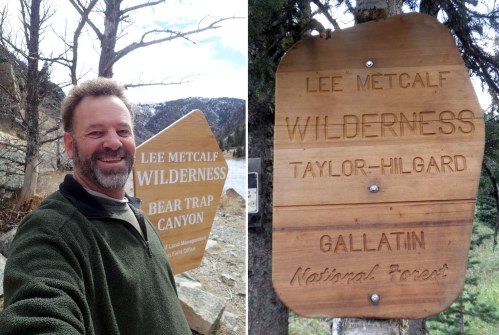
Montana’s Lee Metcalf Wilderness Area includes both BLM and Forest Service lands.
Both agencies oversee grazing permits with private ranch operations. Both agencies must employ recreation specialists, grazing specialists, mining specialists, timber specialists, wildlife biologists, fire-fighting crews, and a litany of secretaries, managers, supervisors, and public relations specialists.
Our cash-strapped federal agencies are unable to afford such superfluous duplication. Decades of federal budget cuts have necessitated extreme belt-tightening. As noted by a local trail maintenance employee, there were sixty seasonal workers maintaining forest trails in the district when he started work thirty years ago, yet now he is the last one. Some projects are parceled out to private contractors. Other trails are neglected, abandoned, or maintained by volunteer groups such as Backcountry Horsemen.
Additional layoffs have been driven by escalating fire-fighting costs due to encroachment of housing developments bordering federal lands, past management decisions that allowed greater buildup of fuels, and warmer, drier conditions due to climate change.[2] Fire-fighting costs rose from 15 to 55 percent of the Forest Service budget over a twenty-year span[3], forcing drastic cuts to core services. Local district offices have been closed to consolidate remaining employees into ever more centralized offices farther and farther from the forests they manage. The few remaining employees must manage remotely, rarely leaving the office to step foot on the lands they manage. As noted by one former Forest Service employee, whenever they actually left the office, they typically spent six hours per work day driving: three hours to get to a site, one hour to work there, and three hours to drive back. This is no way to manage our public lands. The system is broke and broken.
Failures and Corrections
Proposals to return forest reserves to the Interior Department or to otherwise consolidate public land agencies were debated shortly after the initial separation, appearing in different incarnations through nearly every administration of the 1900s. These efforts were summarized in a 2008 study by the Congressional Research Service titled, “Proposals to Merge the Forest Service and the Bureau of Land Management: Issues and Approaches.”[4] Some administrations proposed transferring the Forest Service to the Interior. Others proposed transferring the General Land Office (predecessor to the BLM) to the Agriculture Department. Meanwhile, national parks were carved out of national forests and transferred back to the Interior under jurisdiction of the National Park Service, established in 1916, a move that was opposed by Forest Service officials.
Following formation of the BLM, proposals surfaced to merge the BLM and Forest Service together. Different administrations favored mostly Agriculture, but sometimes the Interior Department as the principal public lands agency. Several administrations proposed combining the two agencies with others to form a new Department of Natural Resources or some variation thereof. All such efforts died due to interference from political infighting, World War I, the Great Depression, World War II, special interests, and an ongoing tug-of-war between the Interior and Agriculture over the right to manage our nation’s public lands.
The 2008 study was initiated in response to rising wildfire costs in the search for means to make the federal agencies more fiscally efficient. The report outlined potential issues and variables to merging the agencies, without actually formulating any proposals.
The Government Accountability Office (GAO) issued a similar report in 2009 titled, “Federal Land Management: Observations of a Possible Move of the Forest Service into the Department of Interior.” The GAO report did not address merging the agencies, just transferring the Forest Service over to the Interior, which offered few tangible benefits without actually merging the duplicate agencies.[5]
Unable to reach an agreement on merging the agencies, Congress authorized the Interior and Agriculture departments to cooperate where convenient, starting in 1998 and solidified in subsequent years. Known as a “Service First” policy, as of 2012, “The Secretaries of the Interior and Agriculture, subject to annual review of Congress, may establish programs to conduct projects, planning, permitting, leasing, contracting and other activities, either jointly or on behalf of one another; may co-locate in Federal offices and facilities leased by an agency of either Department; and may promulgate special rules as needed to test the feasibility of issuing unified permits, applications, and leases.”[6]
In effect, Congress gave broad authorization to the Interior and Agriculture departments to function as one entity to whatever extent deemed practical. However, one of the key challenges to cooperation is that public land agencies developed different rules and procedures for similar functions. For example, is it not uncommon for ranchers to hold grazing leases with both the BLM and Forest Service where agency lands intermingle, but with different laws applying to each lease. If both agencies cooperate as one, the rancher need only meet with one range conservation specialist, but that specialist must understand the rules and procedures of both agencies.[7]
To date, interagency cooperation remains more symbolic than substantive. A list of cooperating projects reveals that the BLM and Forest Service share a common campus in Missoula, Montana, but not the same buildings. The Forest Service pays the BLM its share of a joint janitorial contract. The BLM pays Forest Service employees for cutting timber, and employees from both agencies share many resources. The BLM purchased storage lockers for Forest Service fire employees to store their equipment.[8] These are two separate federal agencies attempting to cooperate from the bottom up in the absence of leadership to merge them together from the top down.
To deal with escalating fire costs, Congress explored the idea of creating an independent U.S. Fire Service. However, part of the fire management effort by the Forest Service and BLM includes ecological management, such as fuels reduction projects, controlled burns, and cooperative timber programs with neighboring private landowners. An independent fire agency would clash with BLM and Forest Service goals.[9]
Congress ultimately agreed in 2018 to treat wildfires like other natural disasters by authorizing an additional $2 billion per year in fire-fighting costs to be shared between the BLM and Forest Service as needed, hopefully reducing the fiscal drain on public land agencies, although the funding doesn’t begin until 2020 and may not keep up with escalating fire-fighting costs.[10]
Through increased cooperation, the BLM and Forest Service are slowly merging into a single entity without actually making the final leap. It is conceivable that the two agencies could ultimately integrate rules and procedures until both utilize the same paperwork. Once merged at the ground level, it would be natural to take the final step to unite the upper hierarchy. Then again, why wait?
Re-emerging the Merge
The split between today’s BLM and Forest Service took root in the 1876 appropriations bill that directed forest funding to the Department of Agriculture instead of the Department of the Interior. Most other public lands are managed by various agencies within the Interior, and the U.S. Forest Service should logically be transferred to that department. The benefits of merely transferring the agency may be negligible, but there is much to be gained by also combining the BLM and Forest Service as a single agency within the Interior.
While the Forest Service principally manages forests and the BLM principally manages rangeland and desert, neither agency is exclusively dedicated to one ecotype or another. For example, in addition to National Forests, the Forest Service oversees National Grasslands, properties that were acquired and rehabilitated by the federal government in the wake of the Dust Bowl and the Great Depression.[11] Therefore, it is reasonable to merge the BLM into the Forest Service while moving the Forest Service to the Interior. The expanded Forest Service would then oversee national forests, national grasslands, and national deserts, all within the Department of the Interior.
Although the BLM oversees more acres of land, the Forest Service is the larger agency with a greater budget and nearly three times as many employees. The Forest Service name should be retained, since it is older, more widely recognized, and less cumbersome than the “Bureau of Land Management.” This proposal completely eliminates a federal agency, the BLM, while retaining all of its offices and employees within the expanded U.S. Forest Service.

Although the BLM oversees more acres of land, the Forest Service is the larger agency with a greater budget and nearly three times as many employees.
Regardless of organizational changes, the land itself would continue to be managed according to pre-existing management plans, at least until those plans are due for revision. All prior programs and commitments would remain ongoing. Merging the BLM and Forest Service would gradually reduce staff duplication, thereby freeing employees to focus on other work that has been neglected due to budget cuts.
The expanded agency would effectively regain local offices in many communities through the merge. If a Forest Service office closed due to budget cuts, but a BLM office still remains, that office now serves the combined public lands from both agencies, bringing forest management back to local communities. Similarly, any existing Forest Service office would now manage former BLM lands in its vicinity, bringing management closer to the land.
There is no need to make such a merger hasty, stressful, or expensive. BLM and Forest Service employees could show up to the same job at the same office, doing exactly the same work as before. Only their letterhead and a sign on the door would be different. Uniforms and badges could be replaced at the regular schedule. Signs could initially be replaced as they wear out or modified with smaller signs or stickers signifying the new agency. The expanded agency could set benchmark goals, such as to switch all BLM grazing leases over to Forest Service leases within five years.
Since the BLM and Forest Service are already cooperatively working together, it is sensible to finalize the marriage and give the expanded agency an official name and address, that being the U.S. Forest Service within the Department of the Interior. That is a small change in comparison to other Cabinet-level shuffling efforts, such as creation of the Department of Homeland Security in 2002, which cobbled together federal agencies from seven different Cabinet level departments.[12] It is time to make an official legislative proposal and make it happen.
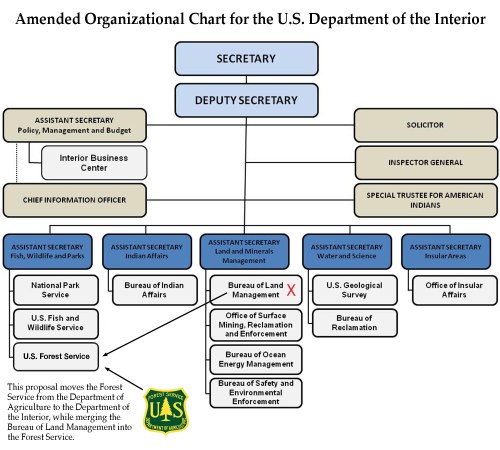
Since the BLM and Forest Service are already cooperatively working together, it is sensible to finalize the marriage and give the expanded agency an official name and address, that being the U.S. Forest Service within the Department of the Interior.
Alternative Mega Merge Options
Merging the BLM and Forest Service into a single agency would greatly streamline public lands management while reducing bureaucracy and redundancy. Continuing this line of reasoning, additional efficiencies could theoretically be attained by merging additional federal land management agencies into a single entity. For example, the U.S. Fish & Wildlife Service presently works across boundaries with the BLM, Forest Service, National Park Service, and other federal lands agencies, while managing its own National Wildlife Refuges. Every agency hires its own wildlife biologists, and part of their job is to coordinate with USFWS wildlife biologists.
In north-central Montana, for example, USFWS manages the Charles M. Russell National Wildlife Refuge and the smaller, embedded UL Bend National Wildlife Refuge, surrounded by public lands managed by the BLM. Wild animals do not recognize jurisdictional boundaries, so USFWS and BLM personnel must coordinate to manage the collective area. If the BLM were merged into the Forest Service, it wouldn’t effectively enhance the management situation. USFWS would still manage the middle, but within Forest Service land instead of BLM land.

The Charles M. Russell and UL Bend National Wildlife Refuges are surrounded by BLM lands, requiring cooperative management between the two different federal agencies.
Therefore, it could be argued that the Forest Service and USFWS should also be merged together. If either agency’s name were retained, that agency would then be in charge of managing all our national forests, national grasslands, national deserts, and national wildlife refuges.
On the other hand, USFWS also works across national parks, monuments, and recreation areas, while offering wildlife enhancement programs on private lands, making an agency merge less practical. A more probable solution is to embed USFWS employees within other agencies. For example, instead of the Forest Service hiring wildlife biologists, USFWS would place their own biologists within Forest Service offices, while the Forest Service would take over management of national wildlife refuges, smoothing out management across borders.
Similarly, this expanded Forest Service could take over management of campgrounds and other recreational lands currently managed by the Bureau of Reclamation or Army Corps of Engineers, which presently hire their own specialists for these tasks.
Consolidating federal land management into a single agency would simplify maps and management, where all federal lands and campgrounds are managed by a single entity, except that we have not yet included the National Park Service. Here again, there is significant duplication where separate federal agencies share common borders.
Consider the Pryor Mountains of south-central Montana. Half the land is managed by the Forest Service and half by the BLM. In addition, BLM lands also border Bighorn Canyon National Recreation Area, which is managed by the National Park Service. Overlapping boundaries with all three federal agencies, the Pryor Mountain Wild Horse Range is cooperatively managed between them, requiring triplicate personnel and paperwork and numerous meetings and MOUs back and forth between the different entities.

Overlapping boundaries with the BLM, Forest Service, and the National Park Service, the Pryor Mountain Wild Horse Range is cooperatively managed between them, requiring triplicate personnel and paperwork and numerous meetings and MOUs back and forth between the different entities.
Management issues are also evident in roads within the Pryor Mountains. Quality roads within Custer National Forest end at the forest boundary. Access on the northwest side traverses heavily rutted clay roads across Crow Indian lands that are only passable when dry. Access from the southeast side traverses similarly poor roads across BLM land, greatly limiting the ability to enter or exit the Pryor Mountains. Merging the BLM and Forest Service and potentially all federal lands agencies together can facilitate more consistent management with less duplication and waste.
In this mega merge scenario, the National Park Service would be elevated to the prevailing public lands agency, absorbing the BLM and Forest Service as well as USFWS lands and other federal public lands. The Park Service already manages national parks, national monuments, national seashores, national recreation areas, etc., so why not also national forests, national grasslands, national deserts, and national wildlife refuges?
A national forest would still be managed with the existing rules as a national forest, but with Forest Service employees rebranded as Park Service employees and all federal land managers working in one theoretically cohesive agency.
Some people might contend that the mega merge would create confusion between national parks and national forests. However, many people who live far from national forests refer to them as national parks anyway, since it is all public land open to recreation and camping. Our national forests effectively function as parks, but with looser rules for camping, recreating, cutting firewood, and hunting, while also allowing commercial grazing, logging, and mining activities.
Consolidating all public lands agencies within the National Park Service is the most sensible, efficient long-term plan, although undoubtedly more politically controversial than merely merging the BLM and Forest Service. In the final analysis, federal policy isn’t determined by what is good or optimal, but what is politically achievable. From that standpoint, merging the BLM and Forest Service within the Department of the Interior is a reasonable and potentially achievable goal, provided someone will assume leadership to shepherd the legislation through Congress.
 Thomas J. Elpel is the author of seven books on wilderness survival, botany, and sustainable living, including Green Prosperity: Quit Your Job, Live Your Dreams. He is president of the Jefferson River Canoe Trail Chapter of the Lewis and Clark Trail Heritage Foundation and the founder/director of Green University LLC of Pony, Montana.
Thomas J. Elpel is the author of seven books on wilderness survival, botany, and sustainable living, including Green Prosperity: Quit Your Job, Live Your Dreams. He is president of the Jefferson River Canoe Trail Chapter of the Lewis and Clark Trail Heritage Foundation and the founder/director of Green University LLC of Pony, Montana.
Notes:
[1] Gorte, Ross W. “Proposals to Merge the Forest Service and the Bureau of Land Management: Issues and Approaches.” Congressional Research Service Report for Congress. May 5, 2008. URL: http://nationalaglawcenter.org/wp-content/uploads/assets/crs/RL34772.pdf.
[2] Moseley, Cassandra. “Why wildfires are bigger and harder to control.” EarthSky Voices. August 2, 2018. URL: http://earthsky.org/earth/why-wildfires-bigger-harder-to-control-wildfire-season-2018.
[3] “Forest Service Wildland Fire Suppression Costs Exceed $2 Billion.” Press Release. U.S. Department of Agriculture. September 14, 2017. URL: https://www.usda.gov/media/press-releases/2017/09/14/forest-service-wildland-fire-suppression-costs-exceed-2-billion.
[4] Gorte, Ross W. “Proposals to Merge the Forest Service and the Bureau of Land Management: Issues and Approaches.” Congressional Research Service Report for Congress. May 5, 2008.
[5] “Federal Land Management: Observations on a Possible Move of the Forest Service into the Department of the Interior.” U.S. Government Accountability Office. February 2009. URL: https://www.gao.gov/assets/290/286048.pdf.
[6] “Laws Authorizing Service First.” URL: https://www.fs.fed.us/servicefirst/authority-legislation.shtml.
[7] Gorte, Ross W. “Proposals to Merge the Forest Service and the Bureau of Land Management: Issues and Approaches.” Congressional Research Service Report for Congress. May 5, 2008.
[8] “Service First Locations: Montana.” URL: https://www.fs.fed.us/servicefirst/sf-loc-mt.shtml.
[9] Gorte, Ross W. “Proposals to Merge the Forest Service and the Bureau of Land Management: Issues and Approaches.” Congressional Research Service Report for Congress. May 5, 2008.
[10] Scruggs, Gregory. “Wildfire funding fix will take ‘a period of years’ to protect U.S. forests.” Reuters. March 26, 2018. URL: https://www.reuters.com/article/us-usa-fires-forests/wildfire-funding-fix-will-take-a-period-of-years-to-protect-u-s-forests-idUSKBN1H21AT.
[11] “United States National Grassland.” Wikipedia. URL: https://en.wikipedia.org/wiki/United_States_National_Grassland.
[12] “United States Department of Homeland Security.” Wikipedia. URL: https://en.wikipedia.org/wiki/United_States_Department_of_Homeland_Security.

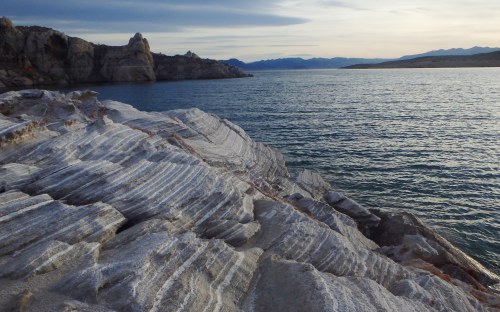






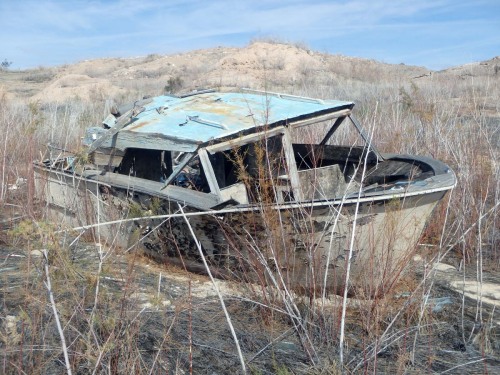
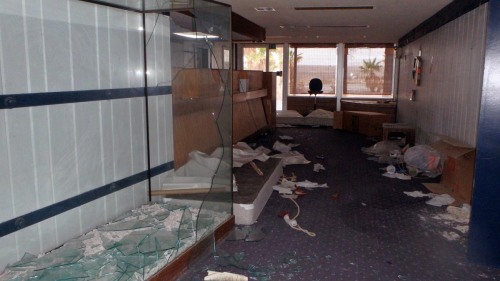













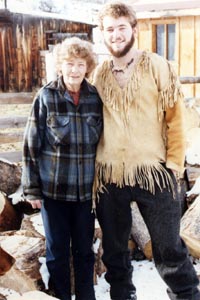



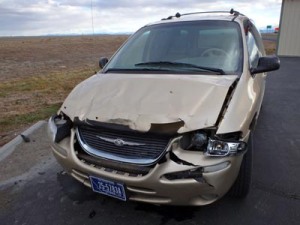

 Thomas J. Elpel Personal Website
Thomas J. Elpel Personal Website